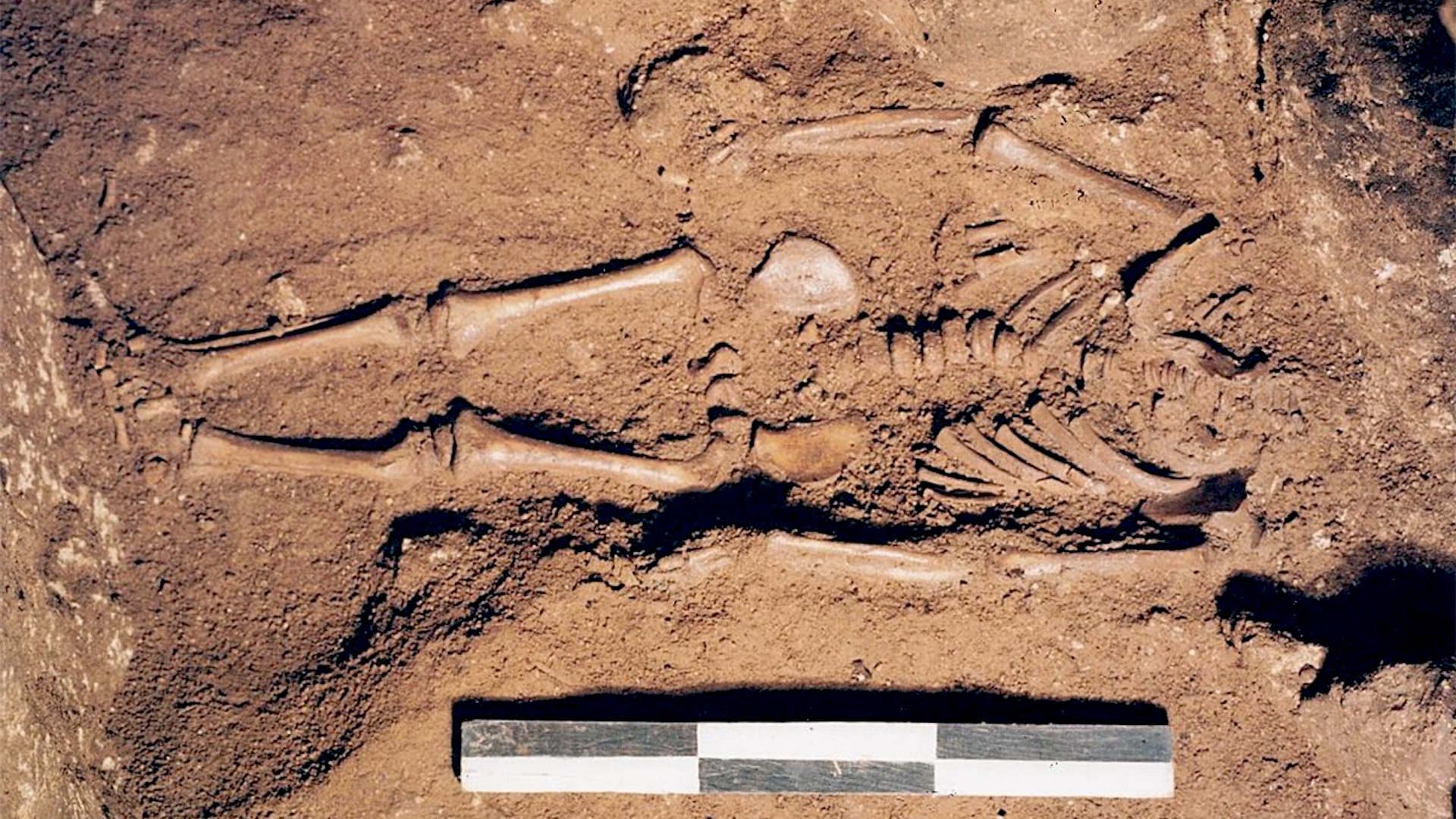17,000-year-old remains of blue-eyed baby boy unearthed in Italy
The well-preserved remains of a baby boy who died 17,000 years ago in what is now Italy reveal that he had blue eyes, dark skin and curly hair.

Scientists have unspooled the life history of an ice age baby who lived in southern Italy about 17,000 years ago, revealing the child most likely died from a congenital heart disease.
The tiny remains of the youngster also showed evidence of poor development and inbreeding, while a DNA analysis revealed that the child was male and likely had blue eyes, dark skin and curly dark-brown to almost black hair, according to a new study, published Sept. 20 in the journal Nature Communications.
Mauro Calattini, an archaeologist at the University of Siena and one of the study authors, found the child's grave in 1998 while excavating the Grotta delle Mura cave in Monopoli, a town in the southeastern Puglia region, or the "heel" of Italy's boot. The burial was covered by two rock slabs and held well-preserved and intact skeletal remains of the baby. There were no grave goods, and it was the only burial found in the cave.
It's rare to find the well-preserved remains of a baby who lived shortly after the Last Glacial Maximum 20,000 years ago, when ice sheets were at their greatest extent. Places like southern Italy were slightly warmer than other parts of continental Europe at that time and likely provided a refuge for the people who buried the baby boy.
Related: Burial of infant 'Neve' could be oldest of its kind in Europe
A skeletal analysis revealed that the child died when he was about 1 year and 4 months old. The child's teeth showed as many as nine accentuated lines, or markers of physiological hardships, indicating that he experienced a difficult life, even while growing in the womb.
"The detailed analysis of the infant's teeth allowed us to infer the health and stress experienced by the child during infancy and/or his mother during pregnancy — something we rarely have the opportunity to explore with such precision," study co-lead authors Owen Alexander Higgins, an archaeologist at the University of Bologna, and Alessandra Modi, an anthropologist at the University of Florence, told Live Science in an email.
Get the world’s most fascinating discoveries delivered straight to your inbox.
Some of the hardships, especially the prenatal ones, may have stemmed from the child's mother. The team looked at the isotopes, or variations of elements with differing numbers of neutrons in the nuclei, in the boy's tooth enamel. Isotopes from drinking water and diet end up in a growing person's teeth, which provides clues about where they lived. "The strontium isotope analysis further revealed that the mother remained in the local area during the last period of her pregnancy," Higgins and Modi said. The mother's reduced movement may have been due to poor health, which in turn may have also affected her fetus, the researchers said.
The DNA analysis also revealed that the baby harbored mutations in two genes — TNNT2 and MYBPC3 — involved in the production of heart muscle proteins. These mutations often lead to hypertrophic cardiomyopathy, a largely genetic condition that makes the walls of the left ventricle thicken and stiffen over time, meaning the heart can't receive or pump out enough blood with each heartbeat. It may have contributed to the early death of the boy, the researchers said.
The boy was genetically related to a band of ice age hunter-gatherers that descended from an ancestral group called the Villabruna cluster, the DNA analysis also showed. The presence of Villabruna ancestry 17,000 years ago meant that for the first time researchers confidently know that such groups were present on the Italian peninsula even before the ice age ended. The boy most likely belonged to a small ancestral group that ultimately populated Sicily and southern Italy, the researchers said. Since the group was small, inbreeding was not uncommon, as evidenced by the boy's parents.
"The analysis of the nuclear genome suggests a high degree of relatedness among the parents, which were likely first cousins," Higgins and Modi said. Although inbreeding wasn't widespread in most Paleolithic people, small group size coupled with isolation made it fairly common in the hunter-gatherers of southern Italy where the boy came from, they added.

Soumya Sagar holds a degree in medicine and used to do research in neurosurgery at the University of California, San Francisco. His work has appeared in New Scientist, Science, Discover, and Mental Floss. He is a passionate science writer and a voracious consumer of knowledge, especially trivia. He enjoys writing about medicine, animals, archaeology, climate change, and history. Animals have a special place in his heart. He also loves quizzing, visiting historical sites, reading Victorian literature and watching noir movies.
